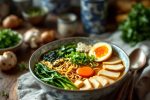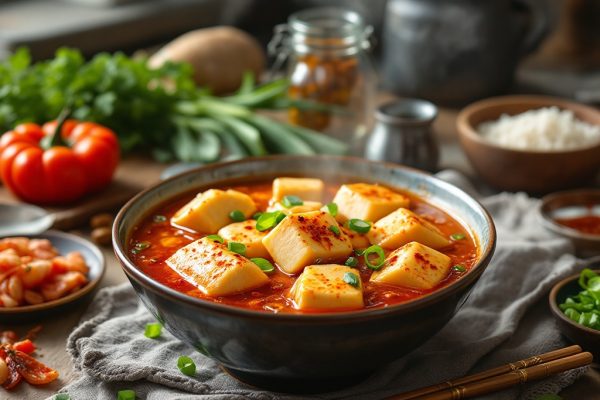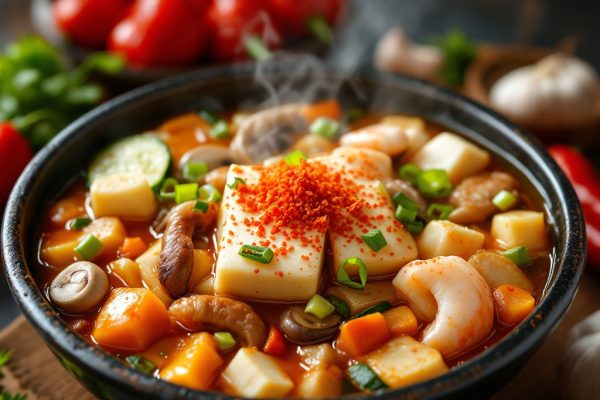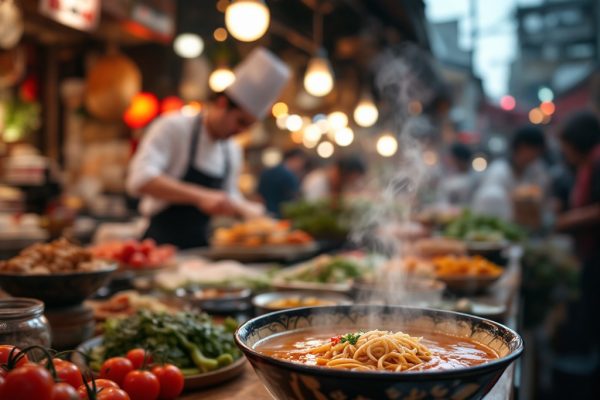Popular Japanese Soups: Dashi Ramen, Tonkotsu Ramen, and Vegan Ramen
Dive into the delicious world of Japanese ramen! From the umami-rich foundation of dashi broth to the creamy pork-bone delight of Tonkotsu and even plant-based vegan options, discover a ramen bowl for every taste. Explore the key ingredients, cooking techniques, and customizable toppings that make each variety unique. Slurp your way through this culinary journey and unlock the secrets to crafting the perfect bowl of ramen at home. Read on to embark on a flavorful adventure!
Important information
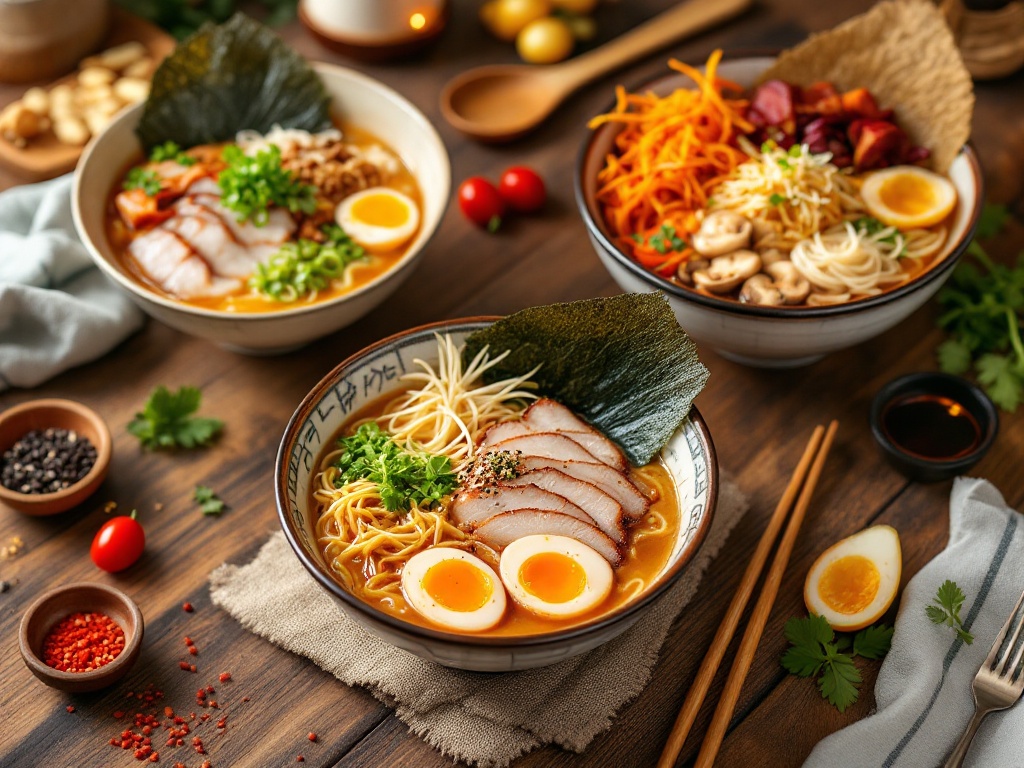
- Dashi, a stock made from kombu (kelp) and katsuobushi (bonito flakes), is fundamental to many Japanese soups, creating a savory umami flavor.
- Tonkotsu ramen features a rich, creamy broth made by simmering pork bones for hours, often topped with chashu pork, green onions, and a soft-boiled egg.
- Vegan ramen uses a plant-based dashi made from kombu and shiitake mushrooms, offering a flavorful alternative. Miso mushroom broth, crispy tofu, and bok choy are key ingredients.
- The perfect ramen involves a balance of flavorful broth, properly cooked noodles, and complementary toppings.
- Ramen toppings can range from classic chashu pork and nori to vegan options like tofu and mushrooms.
Introduction to Popular Japanese Soups
Japanese soups are renowned for their delicious flavors and diverse ingredients. Many begin with a savory, umami-rich broth called dashi, a cornerstone of Japanese cuisine. This umami creates depth and complexity, evident in various soups:
- classic dashi ramen,
- hearty tonkotsu ramen,
- plant-based vegan options.
Japanese soups truly offer a bowl for every taste.
Understanding Dashi: The Foundation of Japanese Soups
Dashi, a simple yet flavorful stock, forms the foundation of many iconic Japanese dishes. These include miso soup, ramen, and various sauces. Its core ingredients, kombu (dried kelp) and katsuobushi (dried bonito flakes), create a rich umami flavor. This savory essence is essential to authentic Japanese cuisine. Beyond flavor, dashi adds depth and complexity to dishes. High-quality kombu and katsuobushi significantly enhance the final taste. Even the generally simple preparation method can influence the dashi’s overall flavor profile.
What is Dashi?
Dashi, a cornerstone of Japanese cooking, is a flavorful stock traditionally made from kombu (dried kelp) and katsuobushi (dried, fermented, and smoked skipjack tuna). This versatile base enhances numerous dishes, adding a savory richness essential to Japanese cuisine. Some popular examples include:
- miso soups,
- clear broths,
- noodle soups.
Importance of Dashi in Japanese Cuisine
Dashi, a cornerstone of Japanese cuisine, is a fundamental soup stock. It’s made with kombu (dried kelp) and katsuobushi (dried, shaved bonito flakes). This combination creates a rich umami, or savory, flavor essential to many Japanese dishes, including miso soup and ramen. Dashi enhances other ingredients, truly elevating the overall flavor profile.
Types of Dashi: Ichiban, Niban, and Vegetarian
Ichiban dashi, the initial brew, offers a light, delicate flavor. Niban dashi, a second brew using the same ingredients, yields a richer, more intense taste. Vegetarian dashi, crafted from kombu (kelp) and shiitake mushrooms, provides a similarly delicious umami flavor without using any animal products. These diverse dashi variations enhance a wide array of Japanese cuisine.
Ichiban Dashi
This initial brew offers a light, delicate flavor.
Niban Dashi
A second brew using the same ingredients, resulting in a richer, more intense taste.
Vegetarian Dashi
Crafted from kombu (kelp) and shiitake mushrooms, this dashi provides a delicious umami flavor without any animal products.
Exploring Dashi Ramen
Dashi ramen relies on a few key ingredients. The base is dashi, a broth usually made from kombu (kelp) and katsuobushi (dried bonito flakes). Chinese-style wheat noodles are crucial. Tare, a seasoning that can be soy sauce or miso, adds a deeper, richer flavor. Aromatic toppings like green onions and nori enhance the taste, while proteins such as chashu pork or marinated eggs complete the dish.
Prepare the dashi: soak kombu in cold water. Gently heat it, then add the katsuobushi.
Cook the noodles according to package directions.
Combine the dashi, tare, and aromatics in a bowl.
Add the cooked noodles and your protein of choice.
Garnish with toppings like green onions and nori.
Key Ingredients of Dashi Ramen
Dashi ramen is a flavorful Japanese noodle soup featuring a rich broth made with dashi, ramen noodles, and a variety of toppings. These often include sliced green onions, nori seaweed, and a protein such as pork, tofu, or chicken. Dashi, a Japanese stock, is crafted from kombu (dried kelp) and katsuobushi (dried, smoked skipjack tuna flakes), giving the broth its savory, umami taste.
Cooking Techniques for Dashi Ramen
Dashi, a fundamental Japanese broth, forms the base of dashi ramen. To prepare it, kombu kelp is soaked in cold water before being gently heated, stopping just short of boiling. Once the kombu is removed, katsuobushi (dried bonito flakes) is steeped in the hot water, then strained to create a clear, umami-rich broth. Noodles are cooked separately according to package instructions and then added to the dashi. Finally, toppings like tender chashu pork, marinated soft-boiled eggs (Ajitsuke Tamago), crunchy menma (bamboo shoots), and vibrant scallions provide the finishing touches of flavor and visual appeal.
Soak kombu kelp in cold water.
Gently heat the water with kombu, stopping just before it boils.
Remove the kombu.
Steep katsuobushi (dried bonito flakes) in the hot water.
Strain the liquid to create a clear broth.
Cook noodles separately and add them to the broth.
Add toppings such as chashu pork, Ajitsuke Tamago, menma, and scallions.
Tonkotsu Ramen: A Rich Pork Delight
Tonkotsu ramen is distinguished by its creamy, pork-bone broth, simmered for hours, sometimes even a full day, to extract rich collagen and fat. This results in a thick, opaque, and intensely flavorful broth.
Key Ingredients
- Pork bones form the base of the broth.
- Pork belly adds richness and flavor.
- Seasonings like garlic, soy sauce, or salt enhance the savory depth.
Classic Toppings
- Chashu, braised pork belly, is a staple.
- Green onions provide a fresh, sharp contrast.
- Nori seaweed adds a subtle umami flavor.
- Soft-boiled eggs with a creamy yolk are essential.
- Wood ear mushrooms offer a pleasant textural element.
The pork bones simmer for 12 to 24 hours, slowly releasing their collagen and fat. This creates the signature creamy texture and rich flavor.
Once the simmering is complete, the broth is seasoned.
Finally, the seasoned broth is combined with noodles and toppings such as tender chashu and vibrant green onions.
What Makes Tonkotsu Ramen Unique?
Tonkotsu ramen is renowned for its broth, simmered from pork bones for upwards of 12 hours. This process yields a cloudy, rich, and creamy texture, extracting collagen and fat from the bones for a deep, unique flavor. Common toppings include chashu (braised pork belly), green onions, and a soft-boiled egg.
Ingredients: Pork Belly and More
Tonkotsu Ramen is renowned for its rich, pork-bone broth. Femur, spine, and trotters simmer for hours, creating a creamy, decadent texture. Pork belly contributes a deep, savory flavor, further enhanced by aromatics like ginger, garlic, and onions. A touch of ginger provides subtle warmth, while soy sauce or miso paste adds saltiness and a boost of umami. The final bowl always features noodles, often topped with scallions and a soft-boiled egg for a complete and satisfying meal.
How to Prepare Authentic Tonkotsu Broth
Crafting real Tonkotsu broth is a labor of love. Pork bones simmer for at least half a day, slowly releasing their collagen and fat to create a rich, opaque, and creamy broth. The result is a truly special, authentic Tonkotsu experience.
Vegan Ramen: A Flavorful Plant-Based Option
Vegan ramen offers a delicious and satisfying plant-based alternative to the traditional dish. The foundation, vegan dashi, is built upon kombu (kelp) and dried shiitake mushrooms, creating a rich, umami flavor similar to traditional dashi. Enhancements like dried daikon radish or sun-dried tomatoes can further elevate the taste.
Key Ingredients
- Miso mushroom broth provides savory richness.
- Crispy tofu adds a delightful textural contrast.
- Bok choy lends a mild sweetness.
Customize Your Bowl
- Corn.
- Bean sprouts.
- Nori.
Prepare the vegan dashi with kombu and dried shiitake mushrooms.
Create the miso mushroom broth by adding miso paste to the dashi.
Press and pan-fry the tofu until crispy.
Cook the ramen noodles according to package directions.
Assemble your bowl with noodles, broth, tofu, bok choy, and desired toppings.
Vegan Dashi: A Plant-Based Alternative
Vegan dashi is a flavorful, plant-based alternative to traditional fish stock. The key to its savory, umami richness lies in kombu kelp and dried shiitake mushrooms. This allows vegans to enjoy the taste of dashi in a variety of dishes, such as soups, stews, and more. It serves as a wonderful base for miso soup or ramen and adds depth to noodle dishes and sauces. Although the preparation may differ slightly from the traditional method, the result is a delicious and versatile ingredient.
Ingredients: Miso Mushroom Broth, Crispy Tofu, and Bok Choy
This vegan ramen features a flavorful miso mushroom broth as its foundation. Crispy tofu adds a boost of protein, while bok choy contributes a delightful crunch. Enhance the dish further with vegetables like seaweed, green onions, or sesame seeds for added flavor and nutrients. The broth’s rich umami flavor comes from the miso and soy sauce.
Steps to Make Vegan Ramen
Sauté chopped onion and garlic in oil until fragrant.
Add dried shiitake mushrooms and water, simmering for 30 minutes to develop a flavorful broth.
While the broth simmers, cook ramen noodles according to package directions.
Combine the cooked noodles, crispy tofu, and bok choy in a bowl.
Pour the rich mushroom broth over the noodles, tofu, and bok choy.
Cooking Techniques for Delicious Ramen
Crafting delicious ramen comes down to three key components: a flavorful broth, perfectly cooked noodles, and a variety of toppings. The broth is the foundation of any good ramen, providing a rich base for the other ingredients. A classic example is Tonkotsu ramen, which uses pork bones for a deep, savory flavor. Alternatively, dashi, made with kombu and dried shiitake mushrooms, offers a lighter, umami-rich option. Noodle selection is equally important, and the ideal choice depends on personal preference. Cooking them al dente ensures a pleasant chewiness. Finally, toppings elevate the ramen experience, adding both flavor and visual appeal. Consider tender chashu pork, marinated eggs, or crunchy bamboo shoots. The careful combination of these elements creates a truly satisfying bowl of ramen.
How to Prepare the Perfect Ramen Broth
Sautéed onion and garlic create a fragrant foundation. Simmering them with dried shiitake mushrooms and other ingredients develops a rich, flavorful base for ramen broth.
Noodles: Choosing and Cooking
Ramen hinges on the perfect noodle. From fresh to dried and instant, each type presents a unique experience.
Fresh Noodles
Fresh noodles offer unparalleled taste and texture.
Dried Noodles
Dried options provide longer shelf life and easier accessibility.
Instant Noodles
Instant noodles deliver ultimate convenience for a quick meal.
Cooking times vary, but the goal is a firm, springy texture. Prevent mushiness by avoiding overcooking and consulting package directions. The broth plays a crucial role, too.
Rich, Thick Broths (e.g., Tonkotsu)
Pair beautifully with thick, chewy noodles.
Lighter Broths (e.g., Shoyu)
Complement delicate, thin noodles.
Ultimately, noodle selection should harmonize with all the ramen elements.
Ramen Toppings for Added Flavor
Classic ramen toppings elevate your bowl to a new level of taste and visual appeal.
- Chashu, tender braised pork belly, is a quintessential choice.
- Narutomaki, a Japanese fish cake, adds a unique swirl of flavor and color.
- Menma, fermented bamboo shoots, provides a savory kick.
- Nori, sheets of dried seaweed, lends a subtle taste of the ocean.
- Eggs, soft-boiled or marinated, create a rich, satisfying element.
- Fresh green onions add a bright, crisp finish.
For vegan ramen enthusiasts, there are equally delicious options to enhance your bowl.
- Tofu provides a substantial and versatile base.
- Mushrooms add depth and earthy notes.
- Bok choy offers a pleasant, slightly bitter counterpoint.
- Corn brings a touch of sweetness and satisfying texture.
- Bean sprouts contribute a refreshing crunch.



